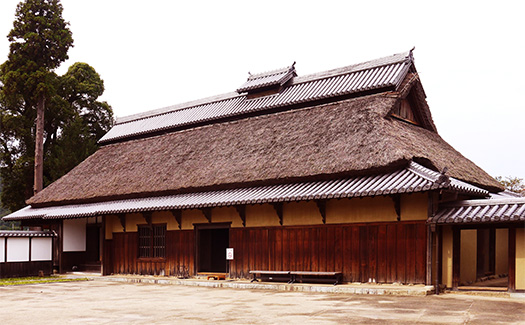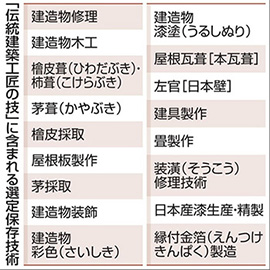

中国発祥のウイルス禍が世界を覆った最悪の1年の最後近くに
「無形文化遺産に「工匠の技」決定 伝統建築守る17技術、ユネスコ」(共同電)
というニュースが飛び込んできました。 以下共同電要旨。
〜国連教育科学文化機関(ユネスコ)は17日オンラインで開いた委員会で、
日本が申請の「伝統建築工匠の技 木造建造物を受け継ぐための伝統技術」の
無形文化遺産登録を決めた。宮大工や左官職人らが古くから継承してきた
17分野の技術の価値が世界的に認められた。
木工や左官、瓦屋根やかやぶき屋根、建具や畳の製作のほか
建物の外観や内装に施す装飾や彩色、漆塗りなど。木や草、土といった
自然素材を活用し日本の伝統的な建築文化を支えてきた。〜
わたしのブログテーマは日本木造技術が育てた高断熱高気密住宅の
さまざまなリアルタイムをお伝えすることですが、同時に
そのさらにベースの日本伝統工匠を深くリスペクトしてきました。
いわば、建築における日本の技術総体を再発見して
民族のものづくりの心ばえを掘り起こしていきたいと思ってきました。
全国各地に仕事や休暇で伺う度、先人の暮らした空間を訪ね歩き
それを支え続けてきた建築職人の工匠にふれてきた。
日本人全体の「空間文化」ということなのだろうと思います。
その技術の最新の進化形として現代の高断熱高気密もあるのだと。
「伝統工法住宅と高断熱化は親和性が高い」とよく言われる。
技術発展マインドにおける同質性・親和性の現れであると。
実際に古民家の高断熱改修は全国各地で広く実践されて完成度も高い。
北海道の武部建設のように古民家改修に非常に積極的なビルダーもいる。

いまある材料を活かして空間の品質を高めていく志向性は
ながく民族が保持し続けてきた建築技術マインドが現代的に活かされたもの。
伝統的工匠技術が、寒冷地・北海道への150年に及ぶ移住という
民族経験のなかで、地域の官・学・民総体でその技術を進化させてきた。
日本民族らしく、北欧・北米由来の断熱技術を柔軟に受容し本質を解読して
伝統的家づくり工法に進化を加えたものだと思います。
いま、高断熱高気密技術は全国各地への拡散・普及時期を迎えています。
そういう時に、世界から日本の建築工匠が認められることは喜ばしい。
大事なのは固守することばかりではなく、知恵と工夫で発展させること。
萱葺き技術はその時代に獲得可能だった材料を活かした断熱であり、
「あたたかい家」へ居住環境を向上させる目的で延命し保持され続けた技術。
そのマインドにおいて日本人の暮らしに寄り添った技術だと思います。
今回ユネスコが認定した日本の建築技術がさらに発展していくために
伝統と未来が合一していくように強く願っています。
The English version is below. ⬇
Near the end of the worst year when the Chinese virus wreck covered the world
” Craftsmanship “decided for intangible cultural heritage; 17 techniques to protect traditional architecture, UNESCO” (Joint Electric)
The news came in. The following is a joint telegram.
~ The United Nations Educational, Scientific and Cultural Organization (UNESCO) is a committee meeting online on the 17th.
Japan applied for “Traditional Architects’ Techniques: Traditional Techniques for Inheriting Wooden Buildings”
Decided to register as an intangible cultural heritage. Miya carpenters and plasterers have inherited it from ancient times
The value of technology in 17 fields has been recognized worldwide.
Besides making woodworking and plastering, tiled roofs and thatched roofs, fittings and tatami mats
Decoration, coloring, lacquering, etc. applied to the exterior and interior of the building. Trees, grass, soil, etc.
Utilizing natural materials, it has supported traditional Japanese architectural culture. ~
My blog theme is a highly insulated and airtight house brought up by Japanese wooden technology.
I will tell you various real times, but at the same time
Furthermore, I have deeply respected the Japanese traditional craftsmanship of the base.
So to speak, rediscovering the whole Japanese technology in architecture
I have wanted to dig up the spirit of ethnic manufacturing.
Every time I visit all over the country for work or vacation, I visit the space where my ancestors lived.
I have come into contact with the craftsmen of the architects who have continued to support it.
I think it is the “spatial culture” of the entire Japanese population.
As the latest evolution of the technology, there is also modern high heat insulation and high airtightness.
It is often said that “traditional housing and high heat insulation have a high affinity”.
It is a manifestation of homogeneity and affinity in the technological development mindset.
In fact, the high insulation renovation of old folk houses has been widely practiced all over the country and has a high degree of perfection.
Some builders, such as Takebe Construction in Hokkaido, are very active in renovating old folk houses.
The intention to improve the quality of the space by utilizing the existing materials
A modern application of the architectural mindset that the people have maintained for a long time.
Traditional craftsmanship is said to have moved to the cold region of Hokkaido for 150 years.
Through ethnic experience, the local government, academia, and the private sector have evolved the technology.
Like the Japanese people, flexibly accept the heat insulation technology derived from Scandinavia and North America and decipher the essence
I think it is an evolution of the traditional house-building method.
Now, the time has come for the highly insulated and airtight technology to spread and spread throughout the country.
At that time, I am happy that Japanese architectural craftsmen are recognized by the world.
The important thing is not only to adhere to it, but to develop it with wisdom and ingenuity.
Thatched technology is heat insulation that makes use of the materials that were available at that time.
A technology that has been extended and maintained for the purpose of improving the living environment for a “warm house”.
I think it is a technology that is close to the lives of Japanese people in that mindset.
For the further development of Japanese building technology certified by UNESCO this time
I strongly hope that tradition and the future will come together.
Posted on 12月 18th, 2020 by 三木 奎吾
Filed under: 住宅マーケティング, 住宅性能・設備, 日本社会・文化研究







コメントを投稿
「※誹謗中傷や、悪意のある書き込み、営利目的などのコメントを防ぐために、投稿された全てのコメントは一時的に保留されますのでご了承ください。」
You must be logged in to post a comment.